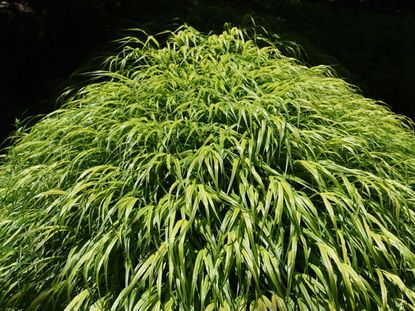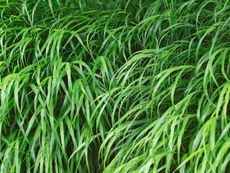Golden Japanese Forest Grass - How To Grow Japanese Forest Grass Plant


Japanese forest grass plant is an elegant member of the Hakonechloa family. These ornamental plants are slow-growing and require little extra care once established. The plants are semi-evergreen (depending on where you live; some may die back over winter) and show best in a partially shaded location. There are several different colors of Japanese forest grass plants. Choose a color that enlivens the surrounding landscape when you are growing forest grass.
Japanese Forest Grass Plant
Japanese forest grass is an attractive, graceful plant that grows slowly and is not invasive. The grass gets 18 to 24 inches (45.5 to 61 cm.) tall and has an arching habit with long flat, foliar blades. These arching blades sweep from the base and gracefully re-touch the earth. Japanese forest grass comes in several hues and may be solid or striped. Most varieties are variegated and have stripes. The variegation is white or yellow. Golden Japanese forest grass (Hakonechloa macra) is one of the more popular types and is a completely sunny, bright yellow variety. The golden Japanese forest grass is best planted in full shade. Sunlight will fade the yellow leaf blades to a white. The leaves get a pink tinge to the edges as fall arrives, increasing the appeal of this easy-to-grow plant. The following cultivars of golden Japanese forest grass are most commonly grown in the garden:
- ‘All Gold' is a sunny, golden Japanese forest grass that brightens up dark areas of the garden.
- ‘Aureola' has green and yellow blades.
- ‘Albo Striata' is striped with white.
Growing Forest Grass
Japanese forest grass plant is suitable for USDA zones 5 to 9. It can survive in zone 4 with heavy protection and mulching. The grass grows from stolons and rhizomes, which will cause it to slowly spread over time. The plant thrives in moist soils in low-light situations. The blades become slightly narrower at the ends and the tips may become dry or brown when exposed to bright light. For best results, plant it in moderate to full shade in a well-drained area with nutrient-rich soil.
Caring for Japanese Forest Grasses
Caring for Japanese forest grasses is not a very time-consuming chore. Once planted, Japanese forest grass is an easy-to-care-for ornamental. The grass should be kept evenly moist, but not soggy. Spread an organic mulch around the base of the plant to help conserve moisture. Hakonechloa doesn't need supplemental fertilizing in good soils but if you do fertilize, wait until after the first blush of growth in spring. When the sun hits the blades, they tend to brown. For those planted in sunnier areas, cut off the dead ends as needed to improve the appearance of the plant. In winter, cut back spent blades to the crown. Older plants can be dug up and cut in half for quick propagation. Once the grass matures, it is easy to divide and propagate a new Japanese forest grass plant. Divide in spring or fall for the best plant starts.
Gardening tips, videos, info and more delivered right to your inbox!
Sign up for the Gardening Know How newsletter today and receive a free download of our most popular eBook "How to Grow Delicious Tomatoes."

Bonnie Grant is a professional landscaper with a Certification in Urban Gardening. She has been gardening and writing for 15 years. A former professional chef, she has a passion for edible landscaping.
-
 Grow a Bathroom Oasis: 8 Best Bathroom Plants With No Light or Low Light
Grow a Bathroom Oasis: 8 Best Bathroom Plants With No Light or Low LightSome apartment dwellers grow the best bathroom plants with no light or low light. Read how one of our favorite plant lovers does it in the big city.
By Teo Spengler
-
 "My Worst Mistake" – Gardeners Share 10 Hard-Learned Lessons
"My Worst Mistake" – Gardeners Share 10 Hard-Learned LessonsGardeners never stop learning, and sometimes our mistakes are the best teachers. But why not save time and heartache by learning from other gardeners' failures?
By Melanie Griffiths
